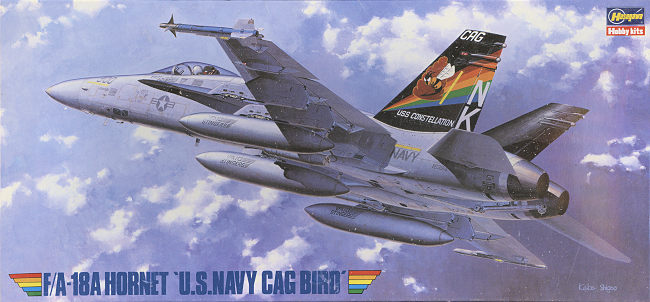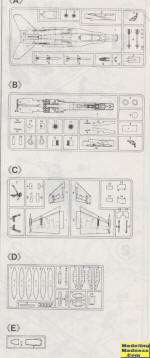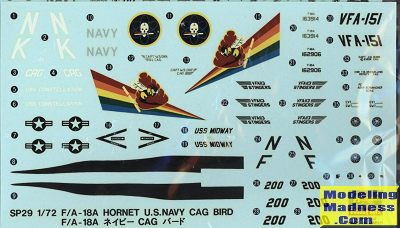
Hasegawa 1/72 F-18A Hornet 'US Navy CAG Bird'
| KIT #: | 51529 (SP29) |
| PRICE: | 1000 yen SRP back in 1990. |
| DECALS: | Two options plus |
| REVIEWER: | Scott Van Aken |
| NOTES: | 1990 boxing |

| HISTORY |
An aircraft designed to replace the A-6 and A-7 in the light and medium strike role, the F-18 Hornet was itself a highly modified design based on the losing USAF light fighter entry, the Northrop F-17 Cobra. A deal was struck between McDonnell/Douglas and Northrop that Northrop would sell a lighter non Navalized version and McDonnell/Douglas would build the other. Northrop, as always seems to happen, got the short end of the stick on that one and did not sell a single complete aircraft. Instead, it was tossed a bone and build subassemblies for McDonnell/Douglas.
The F-18, as with many new airplanes had a rocky start in that it was unable to meet the range and payload requirements. Like a good military, the Navy accepted these deficiencies as they really were not going to get anything else. So the F-18 entered service in the mid 1980s and A-7 units were the ones to transition over. Maintenance people liked them because the systems were new and more reliable. Pilots thought it was OK, but not what they were used to. Eventually, they got over it and the Hornet went on to serve for decades. The A model Hornets have all but been retired from the fleet even after some were upgraded to A+ configuration for the Marines and Reserves. In terms of the USN, the C models have been retired with only Reserves and the Blue Angels flying them. The D models continue to operate with some USMC units, but those are being replaced by the F-35..
| THE KITS |
 Hasegawa
has surely gotten a ton of mileage out of its 1/72 F-18 kits. This is one of
their earliest releases and predates their Limited Edition program. Prior to
that they were released as Specials, hence the SP part number. In this case it
is quite simply an additional set of decals and the inclusion of the then-new
LEREX strakes to take pressure off the vertical fins. As such, the parts are in
excellent shape and free from flash but not from ejector pin marks.
Hasegawa
has surely gotten a ton of mileage out of its 1/72 F-18 kits. This is one of
their earliest releases and predates their Limited Edition program. Prior to
that they were released as Specials, hence the SP part number. In this case it
is quite simply an additional set of decals and the inclusion of the then-new
LEREX strakes to take pressure off the vertical fins. As such, the parts are in
excellent shape and free from flash but not from ejector pin marks.
The kit is the single seat version and so all you get are the bits for that plane. The kits come with a fair cockpit that uses decals for the instrument. An OK bang seat is also provided, but one really should get a resin replacement as the detail is so much better.
Optional bits are to have the boarding ladder up or down (a hole needs filled for up), canopy open or closed, speed brake up or down (rarely seen up), and a choice of Sparrow missiles or the Targeting pods on the fuselage behind the intakes. The kit comes with Sidewinders, but no bombs. There are three drop tanks.
 If you have ever built one of these kits, then the
instructions will be very familiar. As is frequently the case, you get a set of
base line instructions
with a new sheet that includes painting and markings for the special boxing.
Since Hasegawa basically chooses subjects for the home market, it is not
surprising that one of the options would be a CAG 5 aircraft. In this case it is
VFA-151 in low visibility markings. The box art plane with the black fins is
from VFA-113. Both of these squadrons survived the move to the F-18E. The decal
sheet is nicely done but is old style which means it is a bit thick and any
white bits are actually off white. Though they are nearly 30 years old as of
this writing, I've had success using these older decals. There are plenty of
aftermarket sheets out there for those who want to use them. Lerex walk markings as well as cockpit instrument decals are also
included.
If you have ever built one of these kits, then the
instructions will be very familiar. As is frequently the case, you get a set of
base line instructions
with a new sheet that includes painting and markings for the special boxing.
Since Hasegawa basically chooses subjects for the home market, it is not
surprising that one of the options would be a CAG 5 aircraft. In this case it is
VFA-151 in low visibility markings. The box art plane with the black fins is
from VFA-113. Both of these squadrons survived the move to the F-18E. The decal
sheet is nicely done but is old style which means it is a bit thick and any
white bits are actually off white. Though they are nearly 30 years old as of
this writing, I've had success using these older decals. There are plenty of
aftermarket sheets out there for those who want to use them. Lerex walk markings as well as cockpit instrument decals are also
included.
| CONCLUSIONS |
The kit itself is not the simplest build on the planet, with the area around the intakes being the most difficult part. But with some skill and perseverance, you'll have a superb early Hornet.
December 2019
Copyright ModelingMadness.com. All rights reserved.
If you would like your product reviewed fairly and fairly quickly, please contact the editor or see other details in the Note to Contributors.